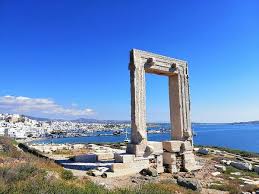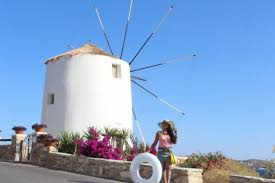Exploring Naxos and Paros: Stunning Beaches, Rich Traditions, and Authentic Greek Island Experiences
Discovering
The Largest Gem of the Cyclades with Stunning Beaches and Rich Agricultural Heritage
Naxos, the largest island in the Cyclades group in Greece, offers a captivating blend of natural beauty, historical richness, and vibrant local culture. Known for its pristine beaches, traditional villages, and fertile lands, Naxos is a must-visit destination for travelers seeking both relaxation and authentic Greek island life. This article dives into what makes Naxos unique, from its landscapes and agriculture to its cultural heritage and tourist attractions.
Location and Overview
Situated in the heart of the Aegean Sea, Naxos is easily accessible by ferry from Athens and other Cycladic islands. Its size and diversity make it stand out from smaller islands like Santorini or Mykonos. With an area of about 430 square kilometers, Naxos offers everything from rugged mountains to sandy beaches, traditional mountain villages, and fertile plains that support a thriving agricultural industry.
Beaches of Naxos: Nature’s Paradise
One of Naxos’s most celebrated features is its long coastline dotted with some of the most beautiful beaches in Greece. The island boasts a variety of beaches suited for different tastes:
-
Agios Prokopios: Famous for its crystal-clear turquoise waters and soft golden sand, it is perfect for families and water sports enthusiasts.
-
Plaka Beach: A long stretch of sandy shore lined with tamarisk trees, offering a more tranquil and natural setting.
-
Agia Anna: Known for its lively beach bars and tavernas, it blends relaxation with vibrant social life.
-
Mikri Vigla: Popular among kite surfers and windsurfers thanks to strong, consistent winds.
The pristine waters and well-maintained facilities make Naxos a beach lover’s paradise, yet the island maintains a relaxed vibe far from the busy crowds seen in more commercialized islands.
Rich Agricultural Heritage: The Heart of Naxos
Unlike many other Cycladic islands that are rocky and arid, Naxos is renowned for its fertile soil and agricultural productivity. The island’s rich farmland produces some of Greece’s finest products, including:
-
Potatoes: Naxos potatoes are famous throughout Greece for their taste and quality.
-
Olives and Olive Oil: Olive groves cover vast areas, and local olive oil is a staple in the island’s cuisine.
-
Cheese: The island produces excellent cheeses, notably the “Arseniko” cheese made from goat’s milk.
-
Citrus Fruits and Vegetables: The mild climate supports the growth of a variety of fruits and fresh vegetables.
Many tourists appreciate visiting traditional villages where they can taste homemade products and experience agricultural traditions that have been passed down for generations.
Cultural and Historical Highlights
Naxos has a deep historical and mythological significance. It is believed to be the place where Theseus abandoned Ariadne, and the island has been inhabited since ancient times.
-
Portara (Temple of Apollo): The iconic marble doorway overlooking the sea is a symbol of Naxos and dates back to the 6th century BC.
-
Naxos Town (Chora): A charming town with Venetian architecture, narrow streets, and a medieval castle (Kastro) reflecting its history under Venetian rule.
-
Ancient ruins and Byzantine churches: Scattered across the island, these sites provide a glimpse into the island’s diverse past.
Visitors can also explore small mountain villages such as Apeiranthos, famous for its traditional stone houses and cultural festivals.
Climate and Best Time to Visit
Naxos enjoys a Mediterranean climate, characterized by hot, dry summers and mild winters. The best time to visit is between May and October when the weather is warm and sunny, perfect for beach activities and outdoor exploration.
Tourist Facilities and Accommodation
Naxos offers a wide range of accommodations, from luxury resorts and boutique hotels to cozy guesthouses and budget hostels. Dining options abound, with traditional tavernas serving fresh seafood, local cheeses, and other island specialties.
Why Choose Naxos?
-
Authentic Experience: Naxos provides a more traditional Greek island atmosphere, avoiding the excessive commercialization of some other Cycladic islands.
-
Natural Beauty: From its beaches to its mountain trails, Naxos offers diverse landscapes for every traveler.
-
Cultural Richness: History and traditions thrive here, offering enriching experiences beyond sun and sea.
-
Accessibility: Well-connected by ferry and airport, making it easy to reach.
Conclusion
Naxos is a hidden treasure in the Cyclades, perfect for those who want to experience the authentic charm of a Greek island coupled with natural beauty and rich culture. Whether you’re lounging on sun-drenched beaches, exploring ancient ruins, or savoring fresh local delicacies, Naxos offers a truly unforgettable holiday experience.
Paros: The Enchanting Cycladic Island Famous for Stunning Beaches and Traditional Fishing Villages
Nestled in the heart of the Cyclades, Paros is a beloved Greek island renowned for its natural beauty, vibrant local culture, and charming traditional fishing villages. With a perfect blend of sun-kissed beaches, picturesque towns, and lively festivals, Paros attracts travelers seeking an authentic yet lively Greek island experience. This article explores what makes Paros a standout destination, highlighting its beaches, culture, history, and reasons why it continues to captivate visitors from around the world.
Location and Overview
Paros is situated centrally within the Cycladic island group in the Aegean Sea. Its strategic location makes it an excellent hub for island hopping between neighboring gems such as Naxos, Mykonos, and Santorini. The island covers an area of approximately 196 square kilometers and offers a mix of coastal landscapes, rolling hills, fertile plains, and quaint villages.
Beaches of Paros: A Diverse Coastal Paradise
Paros is famous for its diverse and well-maintained beaches, each offering a unique experience:
-
Golden Beach (Chrissi Akti): Known for its long stretch of golden sand and clear shallow waters, it’s a hotspot for windsurfing and kitesurfing due to the strong Meltemi winds.
-
Kolymbithres: A stunning beach with unusual granite rock formations creating natural coves and pools, perfect for swimming and photography.
-
Santa Maria: A lively beach with tavernas and bars that provide a festive atmosphere.
-
Pounda Beach: Popular for beach parties and water sports, attracting a younger crowd looking for entertainment.
These beaches, combined with crystal-clear waters and excellent facilities, make Paros a perfect destination for beach lovers and adventure seekers alike.
Traditional Fishing Villages and Local Life
Paros retains a strong connection to its maritime heritage, with several traditional fishing villages that offer a glimpse into the island’s authentic way of life:
-
Naoussa: Once a small fishing village, Naoussa has evolved into a charming town with narrow alleys, whitewashed houses, and a lively harbor filled with fishing boats. The waterfront is lined with cafes, restaurants, and boutiques, making it a vibrant social hub.
-
Parikia: The island’s capital, Parikia, combines modern amenities with historical charm. Its old port and traditional markets provide an authentic Greek island experience.
-
Lefkes: Nestled in the hills, this village is known for its traditional Cycladic architecture, cobblestone streets, and panoramic views.
Visitors often enjoy fresh seafood caught daily by local fishermen, accompanied by local wines and traditional recipes that highlight Paros’s culinary heritage.
Cultural and Historical Significance
Paros has a rich history dating back to ancient times, famously known for its high-quality marble that was used in classical Greek sculpture and architecture.
-
The Church of Panagia Ekatontapiliani: One of the oldest and most important Byzantine churches in Greece, located in Parikia.
-
The Venetian Castle: Overlooking Naoussa, the castle reflects the island’s strategic importance during the Venetian era.
-
Archaeological Sites: Ancient temples, tombs, and remnants of classical civilization can be found throughout the island.
Paros also hosts numerous cultural festivals, especially during the summer months, celebrating religious traditions, music, and dance.
Climate and Best Time to Visit
Paros enjoys a typical Mediterranean climate with hot, dry summers and mild winters. The peak tourist season is from June to September, when the weather is ideal for beach activities and cultural events. Spring and early autumn are excellent times to visit for those seeking a quieter atmosphere and pleasant temperatures.
Tourism Infrastructure and Accommodation
Paros offers a broad range of accommodations to suit all budgets, from luxury resorts and boutique hotels to family-run guesthouses and apartments. The island boasts numerous restaurants, cafes, and bars that serve local specialties and international cuisine. The well-developed transport network, including ferries and buses, makes exploring the island easy and convenient.
Why Tourists Choose Paros
-
Beautiful and Diverse Beaches: Catering to both relaxation seekers and water sports enthusiasts.
-
Authentic Local Experience: Traditional villages combined with vibrant nightlife and cultural events.
-
Rich History and Architecture: A mix of ancient ruins, Byzantine churches, and Venetian castles.
-
Accessibility: Easy connections by ferry and flights, often serving as a gateway to the Cyclades.
-
Welcoming Atmosphere: Warm hospitality and a relaxed pace of life enhance the visitor experience.

